What is GPON? – Basics and The future of GPON in 2023!
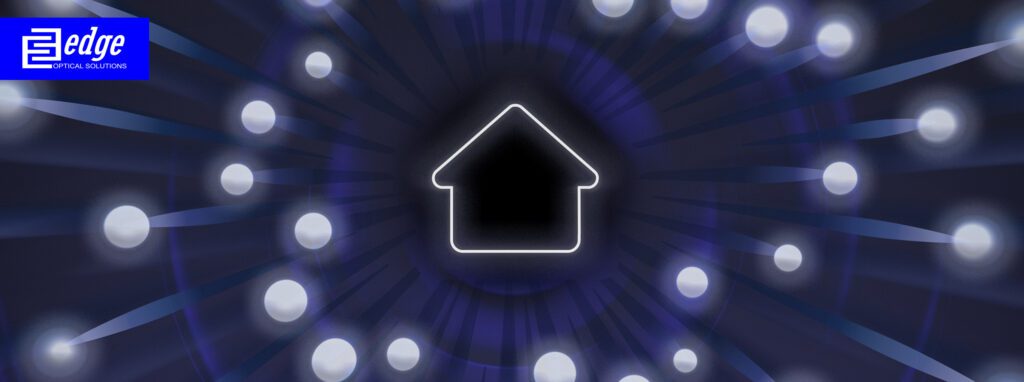
FTTH and GPON technology has been widely used for 10+ years. Sometimes many young newcomers to the industry confuse the terminology and do not really understand how to correctly connect terms such as FTTH, xPON, GPON, EPON, XG-PON and other PON technologies into a common picture. In this article, we will try to structure all this and provide the best possible perspective on PON technologies nowadays, because today is 2023 and PON technology continues to evolve and expand, with faster speeds and improved capabilities. The demand for high-speed internet access is driving the growth of PON technologies, as more and more people rely on the internet for work, entertainment, and communication.
FTTx (fiber to the x) is a collective term that is used to describe various types of broadband network architectures. The “x” stands for a particular object. It could be a home, a cabinet or any end-user premise. As a result, there is Fiber to the Home (FTTH), Fiber to the Building (FTTB), Fiber to the Premises (FTTP) and Fiber to the Curb (FTTC). FTTx has many benefits related to speed and capacity. Other advantages include higher transmission rates and lower energy consumption. FTTx network takes fiber closer to the end-user, which helps in leveraging the latest construction, connection and transmission techniques.
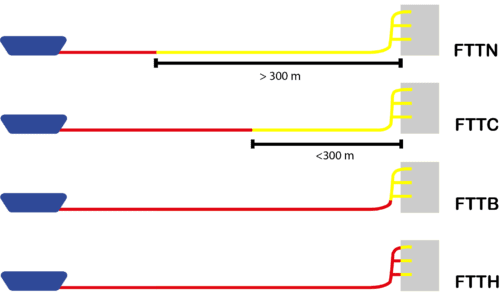
Further on let’s speak about FTTH. So, what is the meaning of FTTH? FTTH is s the delivery of a communication signal via optical fiber from the operator’s switching equipment to home or business, which means that the fiber reaches directly to the living space. This way individual homes, as well as offices both, can utilize the network more efficiently. For example, a single copper pair conductor can receive six phone calls. A single pair of fibers can handle more than 2.5 million phone calls simultaneously. FTTH is also known as FTTP fiber to the premises. When asked what is the difference between FTTH and FTTP, we can say that they are the same thing. These are two terms that get used interchangeably. Both FTTH and FTTP refer to ultrafast, reliable fiber broadband. FTTH network structures could be home run, active star networks and passive optical networks (PON). At present, it is one of the fastest-growing applications worldwide.
Home Run architecture uses a fiber running from the central office (CO) directly to the home/customers. This is primarily used in some of the small setups. It is also known as a point-to-point or P2P network.
Active star type of network leverages fiber from the central office to a local active node carrying multiplexed signals. These signals are then distributed to all customers. It contains a multi-fiber cable leading from the central office to a local network switch.
Passive method. This architecture comprises a Passive Optical Network (PON). Multiple customers can share the same connection, without the need to involve any active components (i.e., components that transform or generate light through an optical-electrical-optical conversion). This technology used a PON splitter, whose directionality can be described as bi-directional. This means that it can send signals downstream from the central office and users can also send signals upstream. These can then be combined into one fiber to communicate with the central office again. The two typical technologies used in this method are the Passive Optical Ethernet Network (EPON) and the Passive Optical Networks with Gigabit capability (GPON).
GPON (Gigabit-capable Passive Optical Network) is a specific type of FTTH that uses fiber-optic cables to provide high-speed internet access. GPON is standardized by the International Telecommunication Union (ITU) as part of the ITU-T G.984 series of standards.GPON uses Wavelength Division Multiplexing (WDM) to allow multiple users to share the same fiber-optic connection while still receiving high-speed internet connectivity. The term Passive Network comes from the fact that GPON does not require active components (like amplifiers or repeaters) along the optical fiber.
GPON technology consists of mainly two active transmission equipment, – Optical Line Terminal (OLT) and Optical Network Unit (ONU) or sometimes called as well as Optical Network Terminal (ONT).
A single Single Mode optical fiber from the OLT runs to a passive Optical Splitter (passive means, it does not require any power to operate) which is located near the users’ locations. The Optical Splitter divides the optical power into N separate paths to the users. The optical paths can vary between 2 to 128. From the Optical Splitter, a single optical strand runs to each user ONT. This is shown in figure:
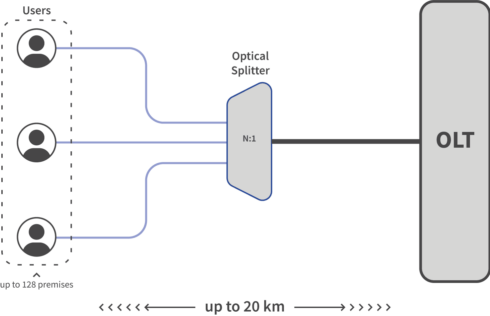
GPON adopts two signal multiplexing mechanisms – for downstream and upstream separate technology. In downstream direction (i.e. from Optical Line Terminal to the users), data packets are transmitted in an broadcast manner, with AES encryption to prevent eavesdropping on adjacent channels. But in the upstream direction (i.e. from users to OLT), data packets are transmitted in a TDMA manner.
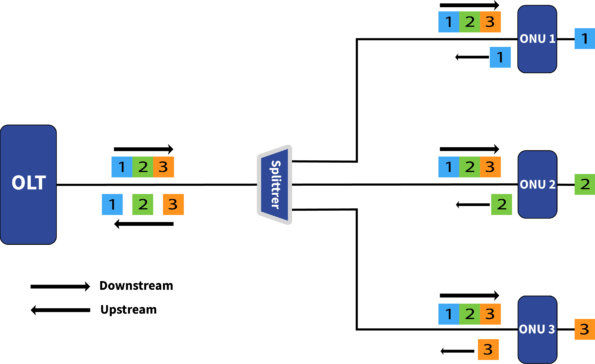
GPON Encapsulation Method (GEM) is a standard for encapsulating data in optical fiber networks. It is used in GPON networks to multiplex multiple data streams into a single optical fiber. GEM provides a way to divide the available bandwidth into multiple virtual channels, each of which can carry different types of traffic, such as video, voice, and data, in an efficient and flexible manner.
A larger group of GEM ports are kept in a single Transmission Container (T-Cont). A Transmission Container (T-CONT) is an ONU object representing a group of logical connections that appear as a single entity for the purpose of upstream bandwidth assignment on the PON.
ITU-T recommendation G.984.3 describes the GPON TC layer which is equivalent to the Data Link layer of the OSI model. It specifies GPON frame format, the media access control protocol, OAM processes and information encryption method. In the next picture we can observe GTC frame structures for downstream and upstream directions. The downstream GTC frame consists of the physical control block downstream (PCBd) and the GTC payload section. The upstream GTC frame contains multiple transmission bursts. Each upstream burst consists of the upstream physical layer overhead (PLOu) section and one or more bandwidth allocation intervals associated with a specific ALLOC_ID.
Each GTC payload contains a GEM Frame with payload data for users.
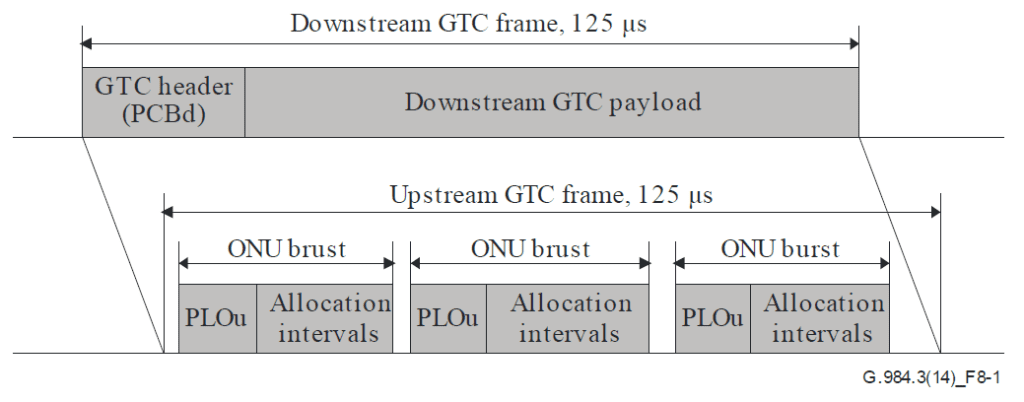
The three main components of GPON is:
- OLT – Optical Line Terminal is located in the service provider’s central office and acts as the central point for the GPON network. It provides the interface to the service provider’s network and the connection to the customer premises;
- ONT – Optical Network Terminal is located at the customer’s premises and provides the interface between the GPON network and the customer’s devices. The ONT acts as an home gateway and connects end user devices to the network;
- Optical fiber & Passive Optical Splitters – The optical fiber carries the signals between the OLT and the ONT and provides the high-speed, high-bandwidth connection that makes GPON such an attractive solution for broadband services. Connections between OLT and customer ONT`s are made with Single mode Single Fiber optical fiber. Signals to and from different customers are splitted through passive optical splitters, which does not require electrical power to do the splitting.
GPON OLT transceiver is designed for use on the OLT side of GPON network. OLT is an equipment integrating L2/L3 switch function, which is located in the central office (CO). The main function of it is to control the information in both directions – upstream and downstream. When speaking about upstream and downstream, an OLT module uses DFB laser transmitter operating at nominal wavelength 1490 nm and 1310 nm APD Photodiode receiver. The GPON OLT module is used for connecting a single-mode fiber patch cable to a passive optical splitter. In result, GPON OLT transceivers work to get data, voice and video traffic from metro networks or from a long-haul network.
Both GPON ONU and GPON ONT are deployed at customers’ premises. ONU/ONT transceiver is the physical connection between the customer premises and the central office OLT in the GPON network. Regarding the signal they receive from OLT, they have opposite wavelengths of the GPON OLT module. The GPON ONU/ ONT module also uses a DFB laser transmitter operating at nominal wavelength 1310 nm and 1490 nm APD Photodiode receiver. The ONU/ ONT SFP module provides end users with a smooth upgrade to GPON. To sum up, the GPON ONU/ ONT SFP module plays an important role in the applications for point-to-multipoint (P2MP) ONT / ONU equipment in the GPON network.
GPON SFP transceivers are categorized into GPON Class B+ modules and GPON Class C+ modules. The main difference between the two is their values of transmitter power and receiver sensitivity, which results in the optical power budget. B+ transceivers have a lower optical budget and C+ describes a higher budget. In the table below the differences are listed.
| GPON Transceiver comparison | |||||
|---|---|---|---|---|---|
| GPON SFP transceiver | Class B+ | Class C+ | |||
| Wavelength: | TX: 1490nm; RX: 1310nm | ||||
| Data Rate: | TX: 2.488 Gbps; RX: 1.244 Gbps | ||||
| Minimum Output Optical Power: | 1.5 dBm | 3 dBm | |||
| Maximum Output Optical Power: | 5 dBm | 7 dBm | |||
| Receiver Sensitivity: | -28 dBm | -30 dBm | |||
| Receiver Overload: | -8 dBm | -12 dBm | |||
| Connector Type: | Single SC | ||||
| Fiber Type: | Single-Mode Fiber (SMF) | ||||
| Distance: | 20 km | ||||
| Optical budget: | 29.5 dB | 33 dB | |||
Factors such as growth of bandwidth-intensive applications, smart cities, IoT penetration, proliferation of 5G, GPON for mobile backhauling, etc., mean that GPON and its upcoming upgrades like NG-PON2 are the optical networks of choice. These are the main advantages of GPON:
- Less physical equipment required & affordable – GPON reduces the reliance on and cost of physical equipment in the fiber distribution network. No physical switches are necessary. Because a single fiber can be split into many different signals, less fiber is required. A GPON network is thus cheaper and quicker to construct;
- Energy-efficient – as a passive system, GPON utilizes very little electricity to operate. It is also 95% more energy-efficient than the legacy copper networks;
- Higher speeds – GPON offers higher bandwidth delivery of 5 gigabits per second (Gbps) downstream and 25 Gbps up to the hub. For larger businesses, scalability enables you to provide a seamless path up to 40 Gbps without upgrading the cabling;
- Flexible – with a single network, you can achieve full coverage for data, surveillance cameras, voice, Wi-Fi backhaul, and other network functions required for business. Because of the number of passive components, it lends itself more easily to centralized management, compared to an active Ethernet network;
- Stable – the advantage is also the stability that GPON delivers even in heavy traffic demand. It ensures a minimum bandwidth allocation to end-users at all times, thus ensuring steady connectivity with the use of PON splitters. It also remains free from electromagnetic or radio interference due to the inherent nature of fiber optics.
Like any technology, we can always list some drawbacks about GPON as well:
- GPON technology is based on splitting and sharing the bandwidth amongst multiple users. In an increasingly bandwidth-intensive world where multi-gigabit networks are starting to become the standard, this might become less than ideal;
- Fiber optic cables are very sensitive to physical bending, kinks or breakage. If they are installed without proper orientation and protection, they can damage the line and reduce their performance.
The market of GPON is established to grow by 5.8% till 2025. Market growth is propelled by the high demand of GPON services, increasing demand for high speed broadband services, advancement in GPON technology, and trial and deployment of the 5G network.
Up to now, still the main leaders of the GPON market are Huawei, Nokia, ZTE, FiberHome, DASAN Zhone, Calix and ADTRAN. Huawei holds its leading position as it has the most comprehensive array of Huawei GPON OLT and ONT products to provide. Nokia is the second largest player in GPON technology. Nokia GPON provides high-capacity PONs for cable operators, fixed networks for mobile transport, and universal next generation PONs. Nokia is considered to have the highest brand value in the GPON market. This may primarily be because of the strong presence in the networking market and also the acquisition of Alcatel-Lucent.

As we have stated before GPON is a network access level technology which offers Gigabit per second data transfer speeds and does not require electrical equipment on the route to the customer. But there are also other technologies which can handle data transmission services in the same access network segment:
- EPON technology, which is similar to GPON, but uses Ethernet protocols instead of GEM. It provides lower latency and higher data rates than GPON, but has a limited maximum distance of 20 km;
- XGPON technology which is same as GPON, but offers higher data rate and is capable to deliver 10G symmetrical data rate ( downstream and upstream);
- 10G-EPON: This technology is an upgraded version of EPON that provides higher data rates and improved performance. It is capable of delivering symmetrical bandwidth up to 10 Gbps.
- And last but not least Active Ethernet (AE): Active Ethernet technology in other words is the same Point-to-Point (P2P) technology that uses a centralized switch to manage the network, rather than the passive optical splitter used in GPON and other PON technologies. This results in a more flexible and scalable network, but also requires more maintenance and higher costs due to required active switches in between the service provider and customer.
Worth mentioning are also two traditional copper-based technologies ADSL (Asymmetric Digital Subscriber Line) and VDSL (Very-high-bit-rate Digital Subscriber Line) used for delivering high-speed internet access. Compared to GPON technology, the most notable differences are the fact that GPON uses optical fiber as a communication medium, instead of copper wires which are used by ADSL and VDSL therefore GPON has much higher data transmission rate – 2.5Gbps, compared to 8Mbps and 50 Mbps respectively for ADSL and VDSL. Secondly, GPON can offer these high speed services in greater distance, up to 20km, instead of ADSL and VDSL 3 km or less distance.
DOCSIS (Data Over Cable Service Interface Specification) is a standard used by cable providers to provide internet service over a coaxial cable network. The DOCSIS standard provides a way for cable providers to offer high-speed data transfer, including internet access, over the existing coaxial cable infrastructure. If compared to GPON then DOCSIS is old technology which is fixed only on coaxial cable infrastructure which has been installed long ago. Nowadays GPON technologies utilize optical fiber which offers much larger data transfer rates and bigger transmission distances.
If we compare GPON and EPON technologies we can conclude that similar is their task to provide broadband services to homes and businesses, but there are also few significant differences between them.
- Data transfer rates – GPON offers 2.5Gbps downstream and 1.25Gbps Upstream, but EPON 1Gbps in downstream and upstream;
- Protocols: GPON uses GEM protocol, but EPON uses IEEE 802.3ah;
- Architecture – GPON core is OLT which serves many customer ONT`s in the same Optical fiber branch. But EPON mostly utilizes the P2P architecture, where each ONT is directly connected to OLT.
- Costs – Theoretically EPON equipment is less expensive if compared to GPON equipment. Which of course is a more interesting fact for service providers with limited budgets.
Next-generation PON technologies offer service providers a pathway toward converged networks, with multiple services coexisting on the same fiber network infrastructure with different wavelengths. Operators can boost network capabilities while protecting revenue for an efficient, secure and effective upgrade process due to the differences in wavelength.

The next generation (and current) PON technologies are GPON, XGS-PON, NGPON-2, EPON and 10G-EPON.
Coexistence, also known as a WDM component, offers service providers the flexibility to provide differentiated services on the PON without massive upgrades. This flexibility becomes important to leverage existing fiber assets across residential, business and wireless backhaul services. As seen in the image above, the passive coexistence element optically multiplexes and demultiplexes the wavelength of each service onto a single fiber.
Combo PON is a relatively new term known for PON networks. The combo transceivers combine discrete optics for multiple PON technologies and multiplex the services to a single fiber interface. Combo PON transceivers consist of XGS-PON and GPON, 10G and 1G EPON, and even XGS-PON, XG-PON and GPON originating from the same transceiver.
XGPON or, also known as NGPON1, was the first next generation PON standard. It delivered performance that was at least four times better than typical GPON. But due to the fact that it’s implementation required new equipment and due to TDM (time division multiplexing), engineers worked on the new standard NGPON2.
The solution of NGPON2 combines multiple signals onto a single optical fiber by using the different wavelengths and then splits transmission into time slots, in order to further increase capacity. NGPON2 will provide a minimum of 40 Gbps downstream capacity, produced by four 10 Gbps signals of different wavelengths in O-band multiplexed together in the central office with a 10 Gbps total upstream capacity.
What are the differences between FTTH and PON?
In simple words, FTTH can also be a PON. FTTH (Fiber To The Home) is the delivery of a signal from the operator’s switching equipment to home or business, which means that the fiber reaches directly to the living space. Basically, it describes any type of network, where the signal is brought to customers’ homes via optical cable. PON stands for passive optical type of network, which sends signals to FTTH devices.
XPON vs GPON
The main difference between the two technologies is the bandwidth. GPON delivers up to 2.4 Gbps per PON port, while XPON offers 10 Gbps.
GPON vs XGS-PON
As mentioned, GPON delivers up to 2.4 Gbps per PON port. XGS -PON is a next generation GPON, respectively, higher bandwidth version of GPON. GPON is an asymmetric PON, which means that the upstream is 1.25G and the downstream is 2.5G. But as for XGS-PON, it is a symmetrical PON, hence the “S” in the term name, which means “symmetrical”. XGS-PON offers 10G of upstream and downstream speed rates.

